When it comes to unique and flavorful cuts of meat, beef cheek stands out as an often-overlooked gem. Affordable and incredibly versatile, this cut has gained recognition among chefs worldwide for its tender, melt-in-your-mouth texture and intensely rich flavor. Despite its growing popularity in gourmet circles, beef cheek remains underrated in many home kitchens.
This guide dives deep into everything you need to know about this flavorful cut. We’ll uncover its anatomy, highlighting why its marbled fibers contribute to such a satisfying bite. You’ll learn about its impressive nutritional benefits, making it a wholesome choice for hearty meals. To help you get started, we’ll share sourcing tips so you can select the best cuts and explore preparation techniques that enhance its natural flavor.
Whether you’re looking to master slow cooking or experiment with global recipes, this guide has you covered. Beef cheek isn’t just a cut of meat—it’s an opportunity to elevate your cooking while discovering a truly special ingredient. Keep reading to unlock the secrets of this culinary treasure.
What is Beef Cheek?
This delicious protein is exactly what it sounds like: the cheek muscle of a cow. This hardworking muscle plays a significant role in the animal’s daily life, which gives it a uniquely dense and fibrous texture. However, don’t let its initial toughness fool you. When treated with care and cooked slowly, the connective tissues in this flavorful cut break down, transforming it into an unbelievably tender and flavorful cut. It’s a true example of how patience in cooking can turn a humble ingredient into something extraordinary.
The Anatomy of Beef Cheek
The structure of beef cheek is what makes it stand out. Its connective tissues, rich in collagen, are the secret to its remarkable texture. During slow cooking, this collagen melts into gelatin, infusing the dish with a luscious, silky quality that’s hard to match. It’s this transformation that makes beef cheek such a prized ingredient in braises, stews, and other slow-cooked dishes.
Why is this delicious protein unique?
This tender meat is a cut like no other, thanks to its high collagen content and intense flavor. When prepared correctly, the resulting dish is tender, rich, and deeply satisfying. Its beefy essence pairs wonderfully with bold flavors, making it a staple in hearty recipes worldwide. Whether you’re crafting a classic French daube or a spicy Mexican barbacoa, this flavorful cut shines as a centerpiece ingredient that delivers comfort and elegance in every bite.
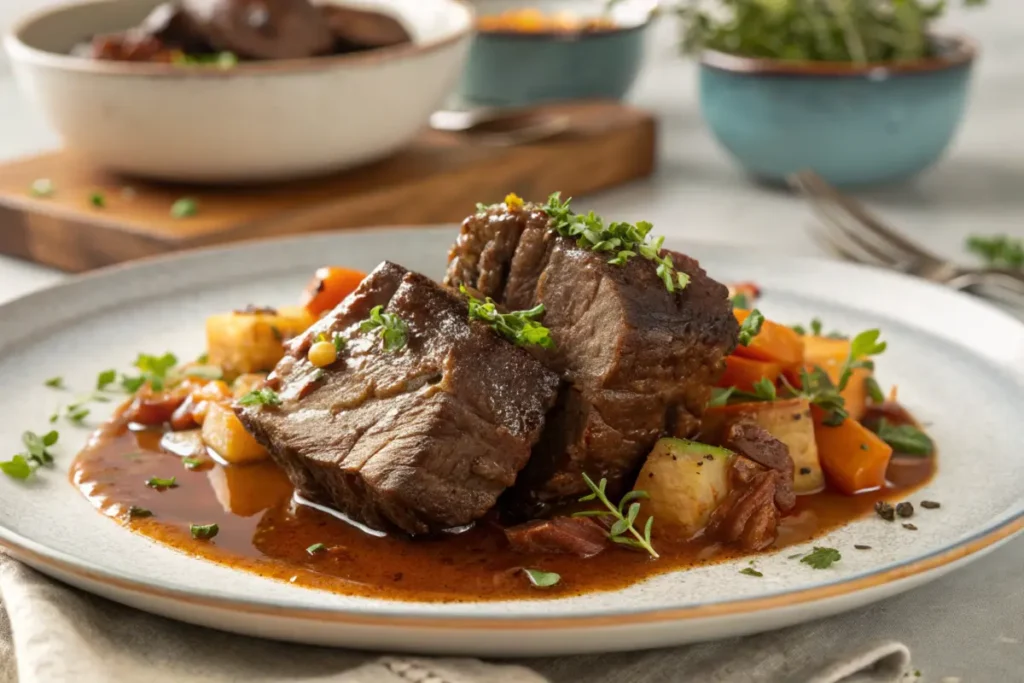
Nutritional Benefits
Beef cheek isn’t just a culinary delight—it’s also packed with nutrients that support a healthy lifestyle. Its combination of protein, essential vitamins, and minerals makes it a powerhouse ingredient for nourishing meals. Let’s break down why this cut deserves a place on your plate.
Protein Content and Health Benefits
One of the standout benefits of this delicious protein is its high protein content. Protein is vital for muscle repair, growth, and overall health, and a single serving of beef cheek delivers a generous portion of your daily protein needs. Whether you’re looking to maintain muscle mass or recover after a workout, this flavorful cut is a delicious way to meet your nutritional goals while enjoying a flavorful dish.
Vitamins and Minerals in Beef Cheek
Beyond protein, beef cheek is rich in key nutrients like iron, zinc, and vitamin B12. Iron supports red blood cell production and prevents fatigue, while zinc boosts immune function and aids in wound healing. Vitamin B12, on the other hand, is crucial for energy metabolism and maintaining a healthy nervous system. Including this tender meat in your diet is an easy way to incorporate these essential nutrients.
Comparing Beef Cheek to Other Cuts
While beef cheek requires a longer cooking time than cuts like tenderloin or ribeye, the wait is worth it. This affordable cut offers a deeper, richer flavor and a uniquely silky texture thanks to its high collagen content. Perfect for slow-cooked recipes like stews and braises, beef cheek transforms into a melt-in-your-mouth experience that rivals more expensive cuts. It’s a flavorful, nutrient-dense alternative that brings both health and taste to your table.
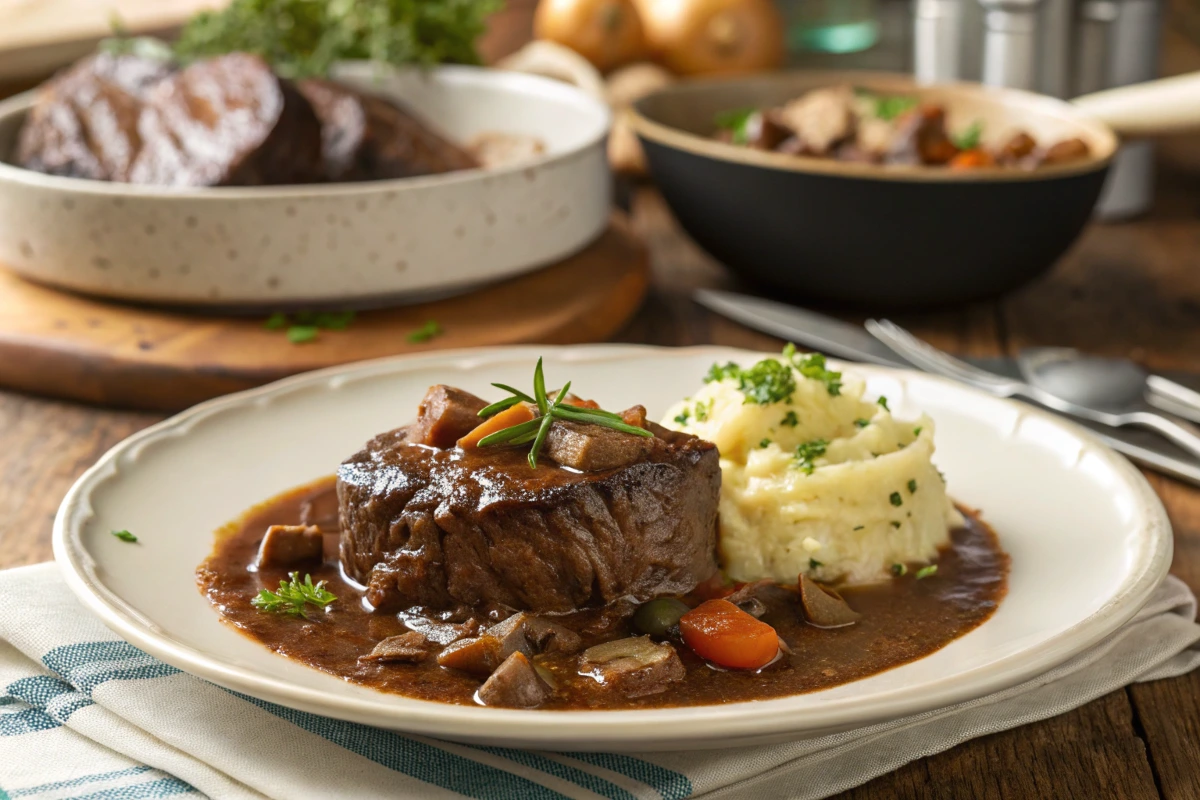
How to Source Quality Beef Cheek
Choosing the right this delicious protein is the first step to creating a flavorful and satisfying dish. With a little knowledge, you can ensure you’re getting a fresh, high-quality cut that will elevate your cooking. Here’s how to source the best beef cheek for your needs.
Tips for Selecting Fresh Beef Cheek
When selecting beef cheek, pay close attention to its appearance and packaging. Fresh beef cheek should have a vibrant, bright red color, which signals freshness and quality. Avoid cuts that look dull or have an unusual smell.
Examine the cut for excessive fat or sinew. While some fat is natural and adds flavor, too much can affect the final texture of your dish. Ideally, choose a piece that’s clean and evenly trimmed.
For the best quality, seek out this tender meat that’s vacuum-sealed or stored in a properly chilled environment. This helps maintain its freshness and reduces the risk of spoilage. If you’re unsure, don’t hesitate to ask your butcher for advice—they can guide you to the freshest and most suitable cuts for your recipe.
Sustainable and Ethical Sourcing Options
For a more conscientious choice, consider sourcing beef cheeks from local farms or suppliers that prioritize ethical and sustainable farming practices. Look for grass-fed or pasture-raised beef, which often boasts better flavor and texture while supporting environmentally friendly agriculture.
Many small-scale farms emphasize humane animal treatment and sustainable land use, making them a great option for ethically minded consumers. By purchasing from these sources, you’re not only enhancing the quality of your meals but also contributing to more responsible farming practices.
Preparing Beef Cheek for Cooking
Cleaning and Trimming Beef Cheek
Before cooking, rinse this delicious protein under cold water to remove any surface debris. Use a sharp knife to trim away excess fat and sinew, but leave some connective tissue intact. This tissue will break down during cooking, adding richness and body to your dish.
Marinating Tips for Enhanced Flavor
To enhance the flavor of your beef cheek, marinate it for several hours before cooking. Here are some tips:
- Use a marinade with acidic ingredients, like red wine or citrus juice, to tenderize the meat.
- Add aromatics such as garlic, onion, and herbs like rosemary or thyme.
- Allow the meat to marinate in the refrigerator for at least 4 hours or overnight for maximum flavor.
Cooking Methods for this tender meat
Slow Cooking Techniques
Braising Beef Cheek to Perfection
Braising is a classic method for preparing beef cheek. By cooking the meat slowly in a flavorful liquid, you can achieve a tender, fall-apart texture. Common braising liquids include beef stock, red wine, and tomato-based sauces.
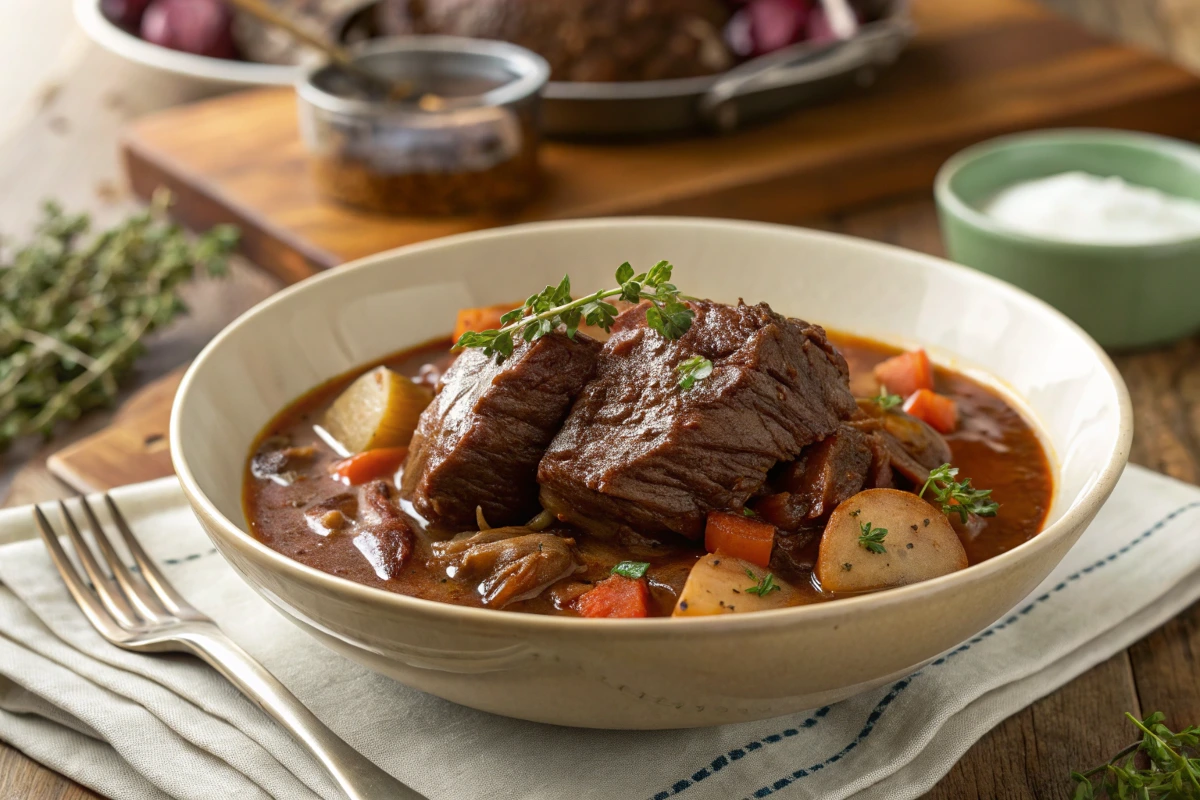
Using a Slow Cooker for Beef Cheek
For a hands-off approach, a slow cooker is an excellent option. Simply add this delicious protein, your choice of liquid, and vegetables to the cooker. Set it on low and let it cook for 8-10 hours.
Sous Vide Cooking for Tender Beef Cheek
Sous vide cooking is another fantastic way to prepare this flavorful cut. By cooking the meat at a precise temperature for an extended period, you can ensure even tenderness throughout. After cooking sous vide, sear the meat in a hot pan for a caramelized crust.
Instant Pot Recipes for Beef Cheek
If you’re short on time, the Instant Pot can help. Pressure cooking beef cheeks for about 45 minutes yields a tender result similar to slow cooking, but much faster.
Global Dishes Featuring Beef Cheek
Beef Cheek in French Cuisine
In France, this tender meat is a key ingredient in Boeuf Bourguignon, a rich stew made with red wine, mushrooms, and pearl onions. This dish highlights the cut’s ability to absorb bold flavors.
Asian Dishes with Beef Cheek
this delicious protein is also popular in Asian cuisines. In Chinese cooking, it might be braised in soy sauce and spices, while Japanese recipes often feature miso and sake-based broths.
Beef Cheek in Latin American Recipes
Latin America embraces beef cheek in dishes like Barbacoa, where it is slow-cooked with chili peppers and spices. The tender meat is then shredded and used in tacos, burritos, or bowls.
Pairing Beef Cheek with Side Dishes
Beef cheek’s rich, tender, and flavorful profile makes it an excellent centerpiece for a variety of side dishes. Choosing the right pairings can elevate your meal, creating a harmonious balance of textures and flavors that leave a lasting impression.
Ideal Vegetables for this flavorful cut Meals
The comforting depth of beef cheek pairs wonderfully with hearty vegetables and creamy sides. Mashed potatoes or creamy polenta are classic choices that complement the meat’s silky texture, offering a satisfying base to soak up the flavorful juices. Their buttery richness balances the bold flavors of the beef.
Roasted vegetables like carrots, parsnips, or Brussels sprouts bring a touch of sweetness and caramelization that enhances the savory beef cheek. Their slight crunch also adds a contrasting texture to the tender meat. For a lighter touch, steamed greens such as kale or spinach provide freshness and a boost of nutrients, making the dish feel more balanced.
These vegetable pairings not only enhance the dish’s flavor but also add visual appeal, creating a vibrant and inviting plate.
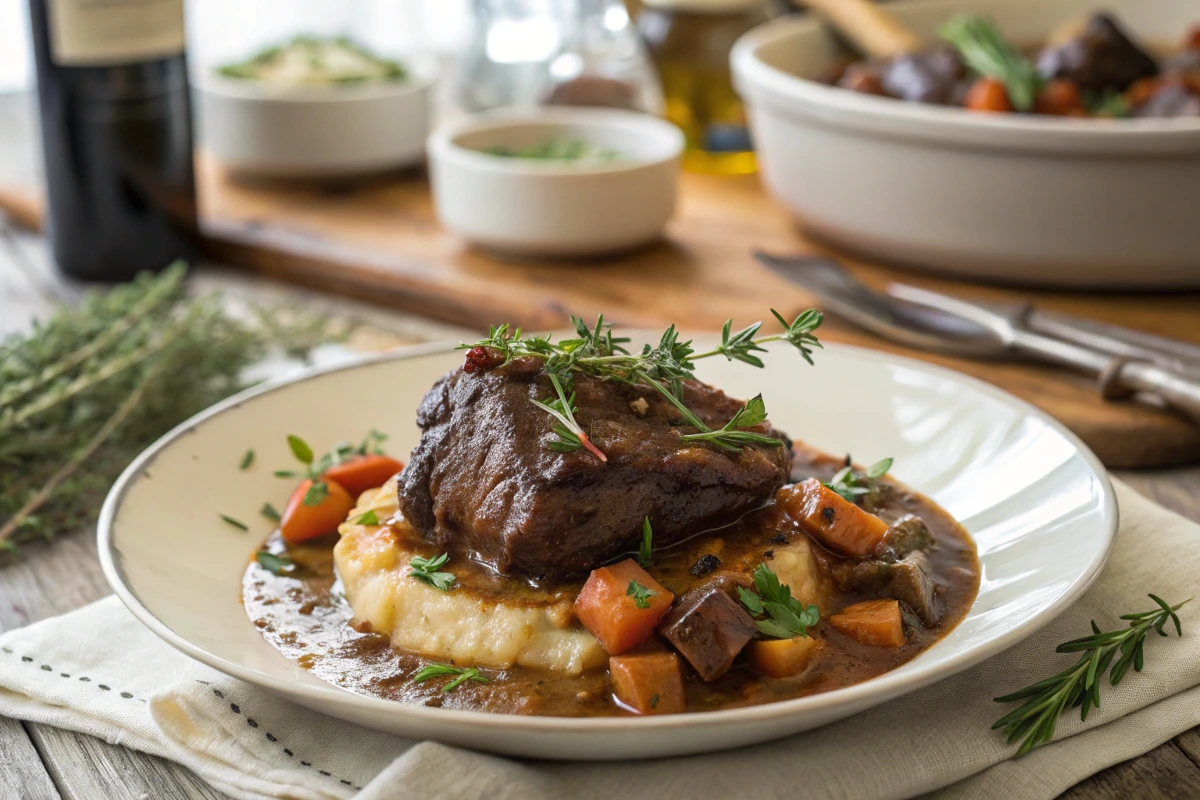
Storing and Reheating
Proper storage and reheating techniques are key to enjoying this delicious protein leftovers at their best. With the right approach, you can preserve its tenderness and flavor, ensuring your next serving is just as satisfying as the first.
Refrigeration and Freezing Tips
Once cooked, this tender meat can be safely stored in the refrigerator for up to three days. Use an airtight container to keep it fresh and prevent any unwanted odors from mingling with your food. If you plan to store it for a longer period, freezing is a great option. Place the beef cheek in a freezer-safe container or tightly wrapped in freezer bags to prevent freezer burn.
For freezing, the beef cheek will maintain its quality for up to three months. When you’re ready to enjoy it again, transfer the frozen portion to the refrigerator and let it thaw overnight. This gradual thawing process helps preserve its texture and flavor, making it taste just as good as when it was first cooked.
Reheating Without Losing Flavor
Reheating it requires a gentle touch to maintain its moist, tender texture. Avoid using the microwave, as it can dry out the meat and diminish its flavor. Instead, opt for the stovetop.
Place this delicious protein in a skillet or saucepan with a small amount of broth, sauce, or cooking liquid to add moisture. Cover the pan with a lid and heat over low flame, allowing the meat to warm through slowly. This method ensures the beef cheek retains its juicy, melt-in-your-mouth quality while reviving its rich, savory flavor.
By following these simple storage and reheating tips, you can enjoy your this flavorful cut leftovers just as much as the original dish, turning every meal into a delicious experience..
Frequently Asked Questions
What Does Beef Cheek Taste Like?
this delicious protein has a rich, beefy flavor and a silky texture due to its high collagen content.
Can You Substitute Beef Cheek in Recipes?
Yes, you can use cuts like short ribs or oxtail as substitutes, though the texture may differ slightly.
Is Beef Cheek Affordable?
Absolutely! this tender meat is often more budget-friendly than premium cuts, making it a great option for gourmet meals on a budget.
How Long Can it Be Stored?
Cooked beef cheek can be stored in the refrigerator for up to 3 days and in the freezer for up to 3 months.
Are There Any Risks to Eating Beef Cheek?
As long as it’s cooked thoroughly, beef cheek is perfectly safe to eat. Always ensure proper cooking temperatures to avoid any potential risks.
What Are the Best Cuts to Pair with this tender meat?
Pair this flavorful cut with cuts like brisket or chuck for a flavorful combination in stews or roasts.

Beef cheek is a versatile and delicious cut that deserves a spot in your cooking repertoire. With its rich flavor, tender texture, and endless culinary possibilities, it’s a must-try for food lovers. Head to your local butcher or grocery store to pick up some of this delicious protein and start exploring the world of flavorful, slow-cooked dishes today!

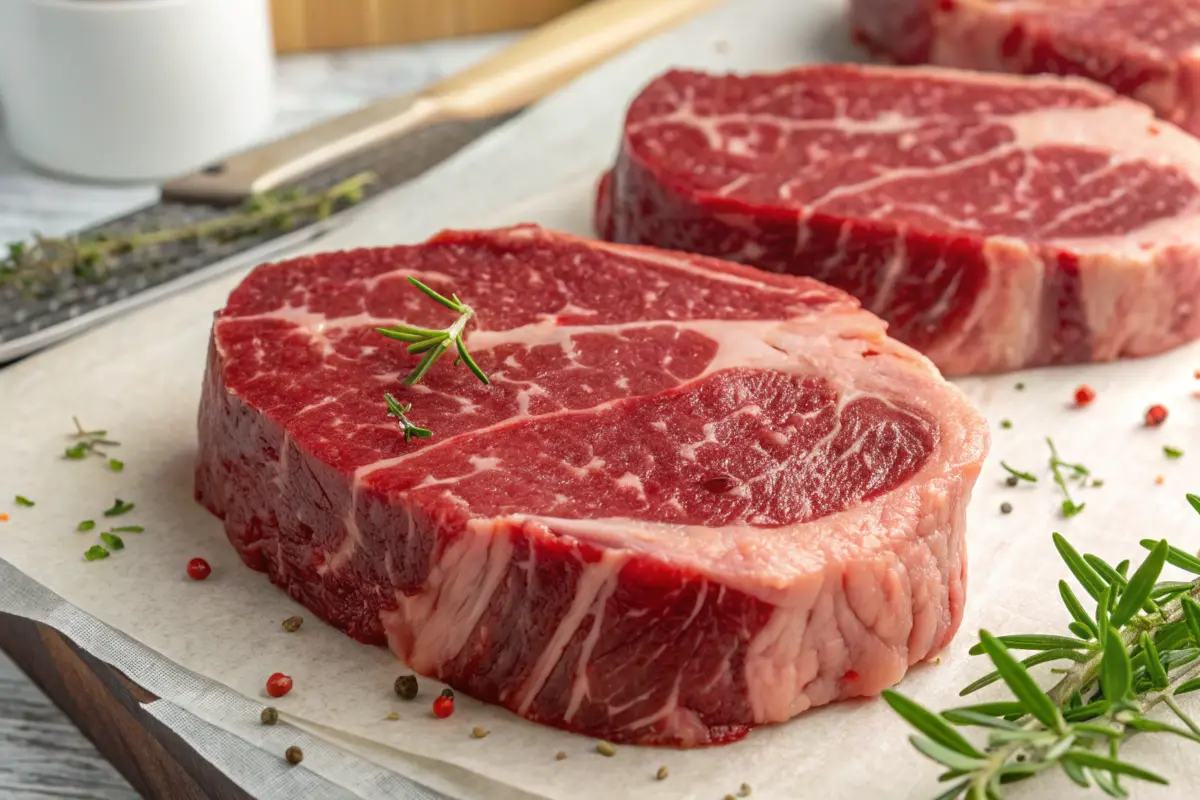
4 thoughts on “Discover Beef Cheek: The Secret to Rich, Flavorful Dishes You’ve Been Missing!”